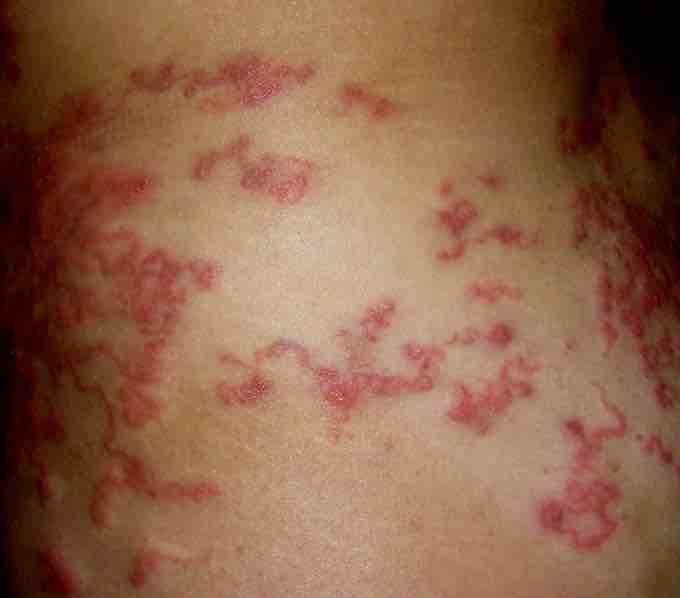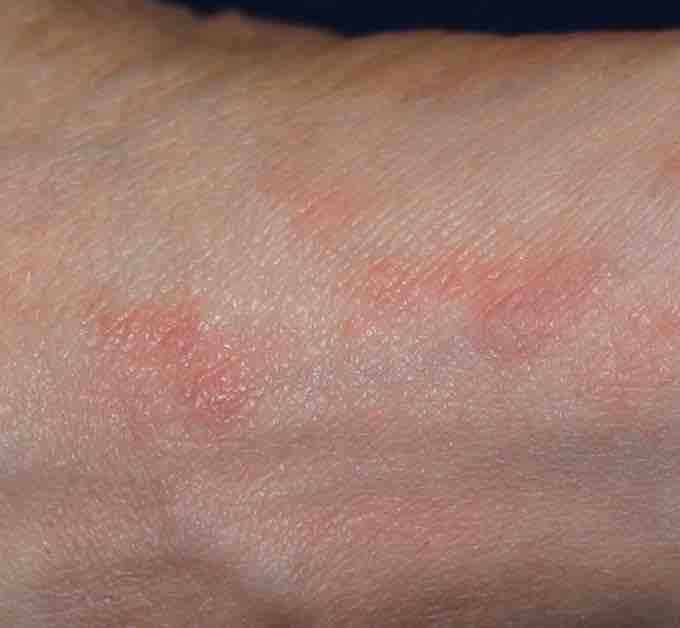A cutaneous condition is any medical condition that affects the integumentary system — the organ system that comprises the entire surface of the body and includes skin, hair, nails, and related muscle and glands. The major function of this system is as a barrier against the external environment. Conditions of the human integumentary system constitute a broad spectrum of diseases, also known as dermatoses, as well as many nonpathologic states (like, in certain circumstances, melanonychia and racquet nails). Common parasitic skin diseases include creeping eruption, lice, and scabies.
Cutaneous larva migrans (abbreviated CLM) is a skin disease in humans caused by the larvae of various nematode parasites of the hookworm family (Ancylostomatidae). The most common species that cayse this disease in the Americas is Ancylostoma braziliense. Colloquially called creeping eruption due to the way it looks, the disease is also somewhat ambiguously known as "ground itch" or (in some parts of the southern U.S.) "sandworms," as the larvae like to live in sandy soil. Another vernacular name is plumber's itch. The medical term CLM literally means "wandering larvae in the skin. " These parasites are found in dog and cat feces and although they are able to infect the deeper tissues of these animals (through to the lungs and then the intestinal tract), in humans they are only able to penetrate the outer layers of the skin and thus create the typical wormlike burrows visible underneath the skin . The parasites apparently lack the collagenase enzymes required to penetrate through the basement membrane deeper into the skin. The infection causes a red, intense itching eruption. The itching can become very painful and if scratched may allow a secondary bacterial infection to develop but it will stop after the parasites are dead. Systemic (oral) agents to treat this infection include albendazole (trade name Albenza) and ivermectin (trade name Stromectol).

Larva Migrans Cutanea
Typical "creeping eruption" associated with cutaneous larva migrans.
Louse (plural: lice) is the common name for members of over 3,000 species of wingless insects of the order Phthiraptera, three of which are classified as human disease agents. They are obligate ectoparasites of every avian and mammalian order except for monotremes (the platypus and echidnas), bats, whales, dolphins, porpoises, and pangolins. Most lice are scavengers, feeding on skin and other debris found on the host's body, but some species feed on sebaceous secretions and blood. Most are found only on specific types of animals, and, in some cases, only to a particular part of the body. Some animals are known to host up to 15 different species, although one to three is typical for mammals, and two to six for birds. For example, in humans, different species of louse inhabit the scalp and pubic hair. Lice generally cannot survive for long if removed from their host. Humans host three different kinds of lice: head lice, body lice, and pubic lice. Lice infestations can be controlled with lice combs and medicated shampoos or washes.
Scabies (from Latin: scabere, "to scratch"), known colloquially as the seven-year itch, is a contagious skin infection that occurs among humans and other animals. The disease may be transmitted from objects, but is most often transmitted by direct skin-to-skin contact, with a higher risk with prolonged contact. Initial infections require four to six weeks to become symptomatic. Reinfection, however, may manifest symptoms within as little as 24 hours. Because the symptoms are allergic, their delay in onset is often mirrored by a significant delay in relief after the parasites have been eradicated. The characteristic symptoms of a scabies infection include intense itching and superficial burrows . The burrow tracks are often linear, to the point that a neat "line" of four or more closely placed and equally developed mosquito-like "bites" is almost diagnostic of the disease. Scabies may be diagnosed clinically in geographical areas where it is common when diffuse itching presents along with either lesions in two typical spots or there is itchiness of another household member. The classical sign of scabies is the burrows made by the mites within the skin. To detect the burrow, the suspected area is rubbed with ink from a fountain pen or a topical tetracycline solution, which glows under a special light. A number of medications are effective in treating scabies with permethrin being the most effective treatment. However, treatment must often involve the entire household or community to prevent re-infection. Options to improve itchiness include antihistamines.

Acarodermatitis
Scabies of the foot.